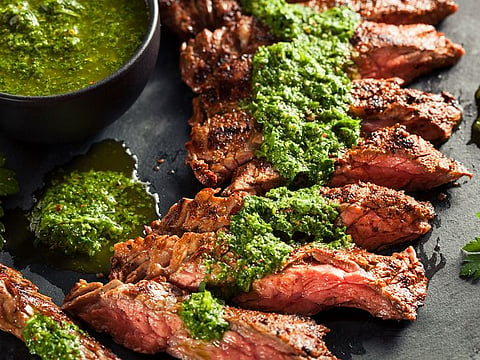Chimichurri on grilled meat? It’s never a ‘mis-steak’
Chimichurri Verde (green) or Chimichurri Rojo (red)? Take your pick on this Argentine dip

The little things do matter – and not just in life – but in food too. When we often think of a sauce or a dip, our minds habitually set camp on ketchup, mustard, pesto, mayo, salsa and so on. But here’s a sauce that does so much with so little, especially when placed on grilled meat. Introducing... Chimichurri.
Did you know?
According to the World Economic Forum’s meat consumption statistics of 2016, Argentina ranks at number three – which means that on an average, citizens eat an average of around 86.1 kg meat every year.
A popular condiment in Argentina and Uruguay, Chimichurri consists of succulent herbs and spices. Moreover, it doesn’t require one to switch on a stove to cook this up and takes less than 10 minutes to make.
But before we delve further into this delicious sauce, here’s all you need to know about Chimichurri…
What are the ingredients?
Made solely from parsley, this condiment consists of oil and varied seasonings (depending on individual preference). In addition to this, there are also other add-ons which can be used ranging from shallots to oregano to even red grape vinegar.
History of Chimichurri
Now that we’ve settled on how tasty this condiment is, going back in time to trace its origins in Argentina, is quite a bit of a task. Often argued upon, the name ‘Chimichurri’ has two versions on how it came to be.
Several polyglots trace it back to the Basque version of tximitxurri – pronounced chee-mee-choo-ree – which loosely translates to ‘a mix of several things in no special order’.
Who are the Basques?
A diasporic group, the Basques have been residing in Argentina ever since the 19th century.
Others argue that it is a combination (or a misspelling) of words known as ‘Jimmy’s Curry’. According to BBC, in the 19th century – James (Jimmy) McCurry, an Irish Immigrant – decided to creative an alternative for Worcestershire Sauce, by using local ingredients available at the time.
It is from there that the sauce is said to have taken his name 'Jimmy McCurry', which later on became 'chimichurri' with Argentinian pronunciation.
No matter where the name came from, there’s always a bowl of chimichurri to go with every plate of meat that gets served in Argentina.
Why is it so popular?
Often referred to as the ‘ketchup of Argentina’ (it’s not)… Chimichurri was first introduced by Spanish immigrants as an accompaniment to conceal the strong taste which comes from freshly butchered, char-grilled meat.
Chimichurri in Argentina is served in a big metal or wooden bowl with asado (another condiment). The sauce also pairs well with chorizo (spiced) sausages or empanadas and is also used rarely as a marinade. While traditionalists often debate over the use of chimichurri on anything other than meat, the Argentine sauce tastes well with bread, fish, and even vegetables.
Researching about Chimichurri helped in debunking certain myths about Chimichurri, some of which include: as mentioned before, it is not ketchup (or like one). It is not supposed to be pureed and it is definitely not the Argentinian version of pesto.
Unique to the country, it is just a simple, uncooked and flavoursome sauce, which can also be used as a dip.
How many types of Chimichurri are there?
Chimichurri Verde (green) and Chimichurri Rojo (red) are the two coloured variations of this sauce. The former is your standard sauce – where the leafy freshness, the pungent taste of garlic and seasoning – create a tasteful blend with grilled meat.
The latter, is a spicier version of the sauce and has ingredients of bell peppers, tomatoes, cilantro, onion and even red grape vinegar.
Today, Chimichurri has found a special place in the hearts of the people of Argentina and stands as a testament to the Argentine cuisine.
Enough about Chimichurri (for now)… What are you waiting for? It’s time to start cooking, here's the recipe.
Send us your favourite dip recipe at food@gulfnews.com
Sign up for the Daily Briefing
Get the latest news and updates straight to your inbox




